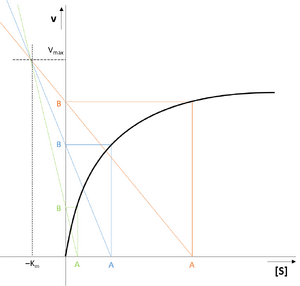Determination of enzyme activity
Enzymes are contained in biological material in very low concentrations. In addition, it is more useful to know their efficiency rather than the amount of enzyme itself to describe biochemical events. Instead of measuring enzyme concentration, the substrate specificity of enzymes and their considerable catalytic efficiency are therefore mostly used to advantage when measuring enzyme activity . We therefore quantify the amount of enzyme indirectly based on the rate at which the enzyme catalyses the conversion of substrate to product in the selected time interval. This method is sufficiently specific provided that only one enzyme acts on the substrate in the given material. It is also sufficiently sensitive and accurate if appropriate concentration of the substrate relative to the enzyme is chosen. It is also a suitable method for determining the decrease in substrate or increase in product over time , or a suitable method for determining the rate of conversion of substrate to product.
Enzyme Activity[edit | edit source]
In order to be able to easily compare the rate of substrate loss or product gain in different time intervals, it is expedient that these rates are constant over time, i.e. that the reaction proceeds according to zero-order kinetics. This can be achieved, strictly speaking, only if all the enzyme is saturated with the substrate, i.e. when all the enzyme of the total concentration [E] t is bound in the form of the enzyme-substrate complex ES. Such a situation occurs only when there is a large excess of substrate. Then the enzyme reaction takes place with the maximum speed V max. In this situation, we can easily define the units of enzyme activity, because if we double the concentration of the enzyme, the maximum speed V max also doubles etc.
Under the condition that the enzyme works in an environment with a considerable excess of substrate, we can therefore kinetically express the amount of enzyme [E] t as the speed V max . The katal (1 kat) is used as a unit of the amount of enzyme, more correctly the amount of enzyme activity . It is the amount of enzyme activity that catalyses the conversion of 1 mole of substrate per second. For practice, this unit is very large, so we usually work with its fractions – micro catalysts (1 μkat = 10 −6 kat), nano catalysts (1 nkat = 10 −9 kat) and pico catalysts (1 pkat = 10 −12 katt ).
In the previous text, we assumed that we observe the speed of the enzyme reaction at the maximum saturation of the enzyme with the substrate (zero-order kinetics), i.e. when the maximum speed V max is reached . Under these conditions, V max is proportional to the enzyme concentration. However, zero-order kinetics can be used approximately even if the enzyme is not saturated with the substrate, i.e. even at lower concentrations of the substrate. However, this is only possible if the substrate concentration [S] does not change too much during the measurement – i.e. it does not decrease too much compared to the initial substrate concentration [S]0. This condition is met if we observe the course of the reaction only in the first minutes, when the decrease in substrate concentration is less than roughly one-tenth of the original value. We refer to the reaction rate in this phase as the initial rate at 0 . The concentration of the enzyme-substrate complex [ES] can also be considered steady-state in this phase . However, with a greater decrease in substrate (decrease in concentration [S]), the concentration [ES] decreases, so zero-order kinetics transitions to first-, second-, and higher-order kinetics.
Michaelis constant[edit | edit source]
Using the initial velocity v0, the relation of this velocity v0 to a certain starting substrate concentration [S]0. can be monitored for a certain assumed amount of enzyme activity . We can therefore deal with the behaviour of the enzyme reaction in situations where the maximum speed Vmax is not reached for the total enzyme concentration [E]t. However, for the same enzyme, the concept of high and low substrate concentration can be relative - it can depend on the specific type of substrate and on the affinity of the enzyme for this substrate. We therefore use a quantity that is a characteristic constant for a given enzyme-substrate pair. It is the so-called Michaelis constant (Km), which indicates such a substance concentration of the substrate at which the speed of the enzyme reaction (v) is half of the maximum speed (Vmax).
Michaelis and Mentenová derived the relationship between Km, [S], v a Vmax:
A low value of Km indicates a high affinity of the enzyme for the substrate. In addition to the fact that Km characterizes a given enzyme-substrate pair, monitoring Km is also necessary to differentiate the mechanism of inhibition (most often competitive or non-competitive type).
Determination of the Michaelis constant[edit | edit source]
The initial rate of the enzyme reaction is more easily measured for low initial substrate concentrations [S]0; at high substrate concentrations, the reaction rate is high, the substrate is quickly consumed, and the reaction rate thus changes substantially within a short period of time from the initiation of the reaction. However, if we plot the reaction rate v against the initial substrate concentrations [S]0, it is difficult to determine the parameters Vmax and Km, directly from this graph , if only measurements at low substrate concentrations are available. Therefore, several procedures have emerged to determine these parameters.
The most frequently mentioned graphic methods include data transformation according to Lineweaver and Burke. Hyperbolic dependence of velocity v substrate concentration [S]
we can easily transform it into a linear function – the inverse of the velocity 1/v depends linearly on the inverse of the substrate concentration 1/[S]:
If we plot 1/v on the vertical axis and 1/[S] on the horizontal axis, under the conditions of 2nd order kinetics, the measured data will lie in a straight line. This straight line intersects the vertical axis at the value 1/Vmax and the horizontal axis at the value −1/Km.
Unfortunately, the method according to Lineweaver and Burke is sensitive even to relatively small measurement errors at low substrate concentrations. A more accurate graphical method for determining the Vmax and Km parameters is Eisenthal and Cornish-Bowden method. The procedure is as follows:
- For several concentrations of the substrate [S] we experimentally measure the reaction rates v. We plot these values in the graph as a dependence of v on [S].
- For each plotted point, we mark the [S] value on the horizontal axis (point A) and the v value on the vertical axis (point B). Let's construct a straight line that passes through points A and B.
- The values of Km and Vmax can be read from the position of the intersection of the straight lines constructed in this way (the intersection has the coordinates [−Km, Vmax]).
Another graphical method is the Eadie-Hofstee plot. Plot v on the vertical axis against v/[S] on the horizontal axis and fit the points with a straight line. Vmax is found as the intersection of this line with the vertical axis, Vmax/Km s the intersection with the horizontal axis, and the slope of the line is −Km.
Although the graphic methods are illustrative, the kinetic parameters are currently calculated using non-linear regression methods.

![{\displaystyle v={\frac {V_{max}\cdot [S]}{K_{m}+[S]}}={\frac {V_{max}}{1+{\frac {K_{m}}{[S]}}}}}](https://wikimedia.org/api/rest_v1/media/math/render/svg/9424b4e5f247badad335f81a11af50d7897741c2)


![{\displaystyle v={\frac {V_{max}\cdot [S]}{K_{m}+[S]}}}](https://wikimedia.org/api/rest_v1/media/math/render/svg/8eda6aa5aa3359bda1809e8612cbc3069bc1320b)
![{\displaystyle {1 \over v}={\frac {K_{m}+[S]}{V_{max}\cdot [S]}}}](https://wikimedia.org/api/rest_v1/media/math/render/svg/b40da210920ab7e4c220175e5110c188b4c84151)
![{\displaystyle {1 \over v}={K_{m} \over V_{max}}\cdot {1 \over [S]}+{1 \over V_{max}}}](https://wikimedia.org/api/rest_v1/media/math/render/svg/904a5028d9114b19392bb710c040ce286b6dfe61)